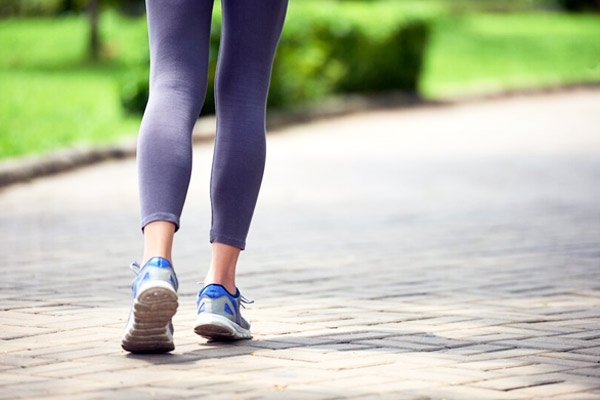
(Image source from: Freepik.com)
Walking is a simple form of aerobic exercise that can help you stay active. However, walking backwards challenges the body in unique ways and helps build strength and flexibility. Walking backwards all day is not a good idea. However, it may be worth adding backwards walking to your exercise routine. Researchers say that during normal walking, propulsion, or forward force, comes from the ankle. When you walk backwards, the power comes from your hips and knees. This switch has many advantages.
Strengthen your muscles: When walking, your gait or gait should extend from heel to toe. That's why, with every step, the heel touches the ground first and then the toe. When walking backwards it is the other way around. The toes touch the ground in front of the heel. This changes the back and leg muscles. Walking backwards has been shown to put more strain on the legs than walking forward. For example, when walking backwards, tense your quadriceps at the front of your thighs to straighten and push your legs backwards. This will help strengthen your lower body muscles. Research shows that walking backwards improves quadriceps strength more than walking forward.
Improves balance and gait: Walking backwards improves gait, gait speed and balance, especially after injury or illness. A review found that retraining combined with other physical therapy improved walking and muscle strength in patients with knee osteoarthritis, juvenile rheumatoid arthritis, and cruciate ligament injuries. Another study examined a backward walking exercise program for people who had suffered a stroke. Balance and walking speed improved compared to standing balance training. More recent studies came to similar results. People recovering from strokes ran backwards on a treadmill for 30 minutes three times a week. They improved their balance, walking speed and cardiovascular fitness within four weeks.
Burn more calories than walking forward: Walking backwards allows you to burn more calories than regular walking because your muscles work harder. The American College of Sports Medicine (ACSM) found that brisk walking at 3.5 miles per hour burns 4.3 METs, or metabolic equivalents. On the other hand, walking backwards consumes 6.0 METs. MET measures the amount of energy your body uses during physical activity. For example, 1 MET is the amount of oxygen you use while resting. According to the ACSM, walking backwards burns about 40 percent more calories per minute than brisk walking. This is a great way to increase exercise intensity.
Improves Cardiorespiratory Fitness: Walking is an excellent aerobic exercise that promotes heart and lung health. Walking backwards is also effective. Walking in the opposite direction improves your cardiovascular fitness and allows your heart and lungs to deliver oxygen more efficiently during exercise. In a small study, young women completed an exercise program that involved walking and running backwards. After six weeks, her body fat decreased and her cardiovascular fitness improved.
Improved flexibility and range of motion: Walking again changes the way you walk, which can improve your flexibility and range of motion and reduce pain. As you come back, your knees straighten before your feet touch the floor. If you have difficulty fully extending your knee due to injury or illness, this repetitive movement will improve your range of motion. It can also increase the flexibility of the hamstring muscles in the ankles and back of the thighs.
Relieve knee pain: According to experts, walking backwards reduces pressure on the knee joint and kneecap. It also strengthens the quadriceps muscles, which support your knees. This can relieve knee pain caused by illness or injury such as osteoarthritis or runner's knee. For this reason, running backwards on a treadmill is one of the techniques that physical therapists use in rehabilitation programs. By changing the direction of walking, the back muscles are stimulated and the spine is stabilized. Researchers believe this could help people with chronic back pain.
Stresses your brain: Walking backwards is also good for your brain. For many people, walking is an automatic process that doesn't require much thought. However, walking backwards requires caution and conscious thought about the movements. This helps you become aware of your body as you move. Learning new things, such as learning retro walking techniques, is one of the many ways to keep your brain sharp. A cognitive study found that people who walked or thought backwards had better short-term memory for past events.
Avoid physical fatigue: If your primary activity is walking, walking backwards is a great way to change up your routine and increase your daily walking level. Changing tasks and challenging muscles in new ways can prevent exercise fatigue. You can also try power walking or Nordic walking.
How to start running backwards on the treadmill:
- Stand on the back of the treadmill with your feet on either side of the belt.
- Attach the safety line to your shirt or pants. Automatically turns off the treadmill when you walk or travel too far.
- Start the treadmill or have someone start it. Make sure you start at a low speed (1 mph).
- Hold onto the side rails as you begin to walk backwards.
- Place your foot back and focus on your toe-to-heel stride. Roll onto your heels, straighten your knees.
- When you are done, turn off the treadmill or ask someone to do so. Go backwards until the treadmill comes to a complete stop.







